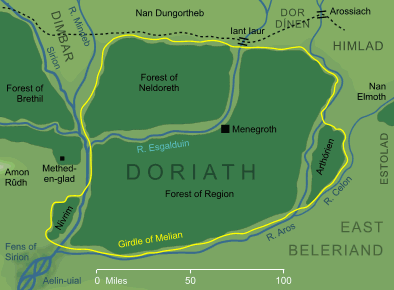Forests of Doriath - a question of climate
Comparing climates across the Atlantic to one another based strictly on latitude ignores the effect of ocean currents and polar air currents, which give Western Europe a much milder climate than the American and Canadian coastal regions of the same latitude. So, for instance, Virginia has a latitude of 36 to 39°N, while the Lorraine region of northern France has a latitude of 47 to 49°N. And, certainly, overall, Virginia has warmer temperatures than Lorraine. But, Virginia has colder winters than Lorraine does. On the graph below, blue is Virginia, and orange is Lorraine.

I thought I would get that caveat out of the way before presenting information about the forests in Europe.
As we know, the forest of Neldoreth is predominantly beeches, while the forest of Nivrim is predominantly oaks. The Forest of Region (south of Neldoreth, east of Nivrim) is dominated by holly, which often grows in oak and beech forests as well.
Here is the distribution of holly across Europe:

So, Region could be modeled on forests with a diverse range of climates, as long as holly is a dominant species there. The particular forest chosen for Silm Film is in France.
Similarly the beech forests that we want to use for Neldoreth seem to give us some flexibility in climate. Not quite as diverse as the holly, but still growing well through much of Europe, including southern England. We chose some of the old growth beech forests in Germany for Neldoreth.
Range of common European beech (
Fagus sylvatica)

Nivrim, to the west of Region, is a bit trickier. To be fair, I am not certain which type of oak is meant to be found in Nivrim: cork oak or turkey oak, or even a hybrid between them:
https://en.wikipedia.org/wiki/William_Lucombe Or even the 'holly oak,' a different tree altogether. But regardless, for all of those we are looking at a tree that enjoys a Mediterranean climate. Oak trees can and do grow in England...but these varieties appear mostly only if you plant them there. There's only really one type of natural oak forest in England (though the climate is changing, so that could change as well).
This is the distribution of cork oak in Europe (
Quercus suber):

Range of the Turkey/Austrian oak (
Quercus cerris)

And, for completion sake, the holly oak/holm oak (
Quercus ilex):

The favored climate of all of the above options is Mediterranean. Luckily, there's another species of oak:
Common oak, European oak, English oak (
Quercus robur)

So, the places I would be comfortable saying that all three of these forests could grow would be: northern Spain, southern England, France, Italy, Germany, Denmark, or the Adriatic coast. That seems to be a good match for the climate of Doriath's forests. We should probably choose a location for Nivrim around there.

































